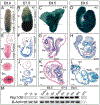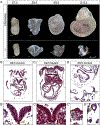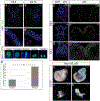Protein phosphatase 1 regulatory subunit 35 is required for ciliogenesis, notochord morphogenesis, and cell-cycle progression during murine development
- PMID: 32628936
- PMCID: PMC7484031
- DOI: 10.1016/j.ydbio.2020.06.011
Protein phosphatase 1 regulatory subunit 35 is required for ciliogenesis, notochord morphogenesis, and cell-cycle progression during murine development
Abstract
Protein phosphatases regulate a wide array of proteins through post-translational modification and are required for a plethora of intracellular events in eukaryotes. While some core components of the protein phosphatase complexes are well characterized, many subunits of these large complexes remain unstudied. Here we characterize a loss-of-function allele of the protein phosphatase 1 regulatory subunit 35 (Ppp1r35) gene. Homozygous mouse embryos lacking Ppp1r35 are developmental delayed beginning at embryonic day (E) 7.5 and have obvious morphological defects at later stages. Mutants fail to initiate turning and do not progress beyond the size or staging of normal E8.5 embryos. Consistent with recent in vitro studies linking PPP1R35 with the microcephaly protein Rotatin and with a role in centrosome formation, we show that Ppp1r35 mutant embryos lack primary cilia. Histological and molecular analysis of Ppp1r35 mutants revealed that notochord development is irregular and discontinuous and consistent with a role in primary cilia, that the floor plate of the neural tube is not specified. Similar to other mutant embryos with defects in centriole function, Ppp1r35 mutants displayed increased cell death that is prevalent in the neural tube and an increased number of proliferative cells in prometaphase. We hypothesize that loss of Ppp1r35 function abrogates centriole homeostasis, resulting in a failure to produce functional primary cilia, cell death and cell cycle delay/stalling that leads to developmental failure. Taken together, these results highlight the essential function of Ppp1r35 during early mammalian development and implicate this gene as a candidate for human microcephaly.
Keywords: Centriole; Cilia; Development; Knockout; Notochord; Ppp1r35.
Copyright © 2020 Elsevier Inc. All rights reserved.
Figures






References
-
- UCDavis. KOMP Repository Knockout Mouse Project. 2019; Available from: http://www.KOMP.org.
-
- Consortium IMP Gene: Ppp1r35. 2019; Available from: https://www.mousephenotype.org/data/genes/MGI:1922853.
-
- Jurand A, Some aspects of the development of the notochord in mouse embryos. J Embryol Exp Morphol, 1974. 32(1): p. 1–33. - PubMed
Publication types
MeSH terms
Substances
Grants and funding
LinkOut - more resources
Full Text Sources
Molecular Biology Databases

